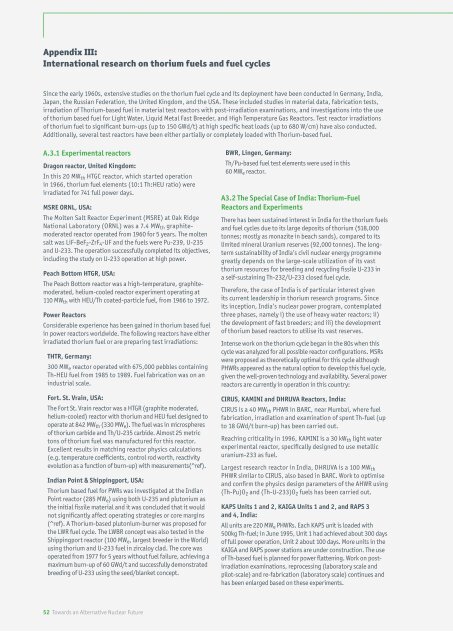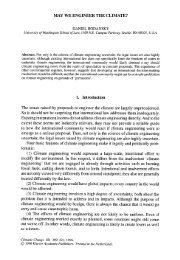ThorEA - Towards an Alternative Nuclear Future.pdf
ThorEA - Towards an Alternative Nuclear Future.pdf
ThorEA - Towards an Alternative Nuclear Future.pdf
Create successful ePaper yourself
Turn your PDF publications into a flip-book with our unique Google optimized e-Paper software.
Appendix III:<br />
International research on thorium fuels <strong>an</strong>d fuel cycles<br />
Since the early 1960s, extensive studies on the thorium fuel cycle <strong>an</strong>d its deployment have been conducted in Germ<strong>an</strong>y, India,<br />
Jap<strong>an</strong>, the Russi<strong>an</strong> Federation, the United Kingdom, <strong>an</strong>d the USA. These included studies in material data, fabrication tests,<br />
irradiation of Thorium-based fuel in material test reactors with post-irradiation examinations, <strong>an</strong>d investigations into the use<br />
of thorium based fuel for Light Water, Liquid Metal Fast Breeder, <strong>an</strong>d High Temperature Gas Reactors. Test reactor irradiations<br />
of thorium fuel to signific<strong>an</strong>t burn-ups (up to 150 GWd/t) at high specific heat loads (up to 680 W/cm) have also conducted.<br />
Additionally, several test reactors have been either partially or completely loaded with Thorium-based fuel.<br />
A.3.1 Experimental reactors<br />
Dragon reactor, United Kingdom:<br />
In this 20 MWth HTGC reactor, which started operation<br />
in 1966, thorium fuel elements (10:1 Th:HEU ratio) were<br />
irradiated for 741 full power days.<br />
MSRE ORNL, USA:<br />
The Molten Salt Reactor Experiment (MSRE) at Oak Ridge<br />
National Laboratory (ORNL) was a 7.4 MWth graphitemoderated<br />
reactor operated from 1960 for 5 years. The molten<br />
salt was LiF-BeF2-ZrF4-UF <strong>an</strong>d the fuels were Pu-239, U-235<br />
<strong>an</strong>d U-233. The operation successfully completed its objectives,<br />
including the study on U-233 operation at high power.<br />
Peach Bottom HTGR, USA:<br />
The Peach Bottom reactor was a high-temperature, graphitemoderated,<br />
helium-cooled reactor experiment operating at<br />
110 MWth with HEU/Th coated-particle fuel, from 1966 to 1972.<br />
Power Reactors<br />
Considerable experience has been gained in thorium based fuel<br />
in power reactors worldwide. The following reactors have either<br />
irradiated thorium fuel or are preparing test irradiations:<br />
THTR, Germ<strong>an</strong>y:<br />
300 MWe reactor operated with 675,000 pebbles containing<br />
Th-HEU fuel from 1985 to 1989. Fuel fabrication was on <strong>an</strong><br />
industrial scale.<br />
Fort. St. Vrain, USA:<br />
The Fort St. Vrain reactor was a HTGR (graphite moderated,<br />
helium-cooled) reactor with thorium <strong>an</strong>d HEU fuel designed to<br />
operate at 842 MWth (330 MWe). The fuel was in microspheres<br />
of thorium carbide <strong>an</strong>d Th/U-235 carbide. Almost 25 metric<br />
tons of thorium fuel was m<strong>an</strong>ufactured for this reactor.<br />
Excellent results in matching reactor physics calculations<br />
(e.g. temperature coefficients, control rod worth, reactivity<br />
evolution as a function of burn-up) with measurements(^ref).<br />
Indi<strong>an</strong> Point & Shippingport, USA:<br />
Thorium based fuel for PWRs was investigated at the Indi<strong>an</strong><br />
Point reactor (285 MWe) using both U-235 <strong>an</strong>d plutonium as<br />
the initial fissile material <strong>an</strong>d it was concluded that it would<br />
not signific<strong>an</strong>tly affect operating strategies or core margins<br />
(^ref). A Thorium-based plutonium-burner was proposed for<br />
the LWR fuel cycle. The LWBR concept was also tested in the<br />
Shippingport reactor (100 MWe, largest breeder in the World)<br />
using thorium <strong>an</strong>d U-233 fuel in zircaloy clad. The core was<br />
operated from 1977 for 5 years without fuel failure, achieving a<br />
maximum burn-up of 60 GWd/t <strong>an</strong>d successfully demonstrated<br />
breeding of U-233 using the seed/bl<strong>an</strong>ket concept.<br />
52 <strong>Towards</strong> <strong>an</strong> <strong>Alternative</strong> <strong>Nuclear</strong> <strong>Future</strong><br />
BWR, Lingen, Germ<strong>an</strong>y:<br />
Th/Pu-based fuel test elements were used in this<br />
60 MWe reactor.<br />
A3.2 The Special Case of India: Thorium-Fuel<br />
Reactors <strong>an</strong>d Experiments<br />
There has been sustained interest in India for the thorium fuels<br />
<strong>an</strong>d fuel cycles due to its large deposits of thorium (518,000<br />
tonnes; mostly as monazite in beach s<strong>an</strong>ds), compared to its<br />
limited mineral Ur<strong>an</strong>ium reserves (92,000 tonnes). The longterm<br />
sustainability of India’s civil nuclear energy programme<br />
greatly depends on the large-scale utilization of its vast<br />
thorium resources for breeding <strong>an</strong>d recycling fissile U-233 in<br />
a self-sustaining Th-232/U-233 closed fuel cycle.<br />
Therefore, the case of India is of particular interest given<br />
its current leadership in thorium research programs. Since<br />
its inception, India’s nuclear power program, contemplated<br />
three phases, namely i) the use of heavy water reactors; ii)<br />
the development of fast breeders; <strong>an</strong>d iii) the development<br />
of thorium based reactors to utilise its vast reserves.<br />
Intense work on the thorium cycle beg<strong>an</strong> in the 80s when this<br />
cycle was <strong>an</strong>alyzed for all possible reactor configurations. MSRs<br />
were proposed as theoretically optimal for this cycle although<br />
PHWRs appeared as the natural option to develop this fuel cycle,<br />
given the well-proven technology <strong>an</strong>d availability. Several power<br />
reactors are currently in operation in this country:<br />
CIRUS, KAMINI <strong>an</strong>d DHRUVA Reactors, India:<br />
CIRUS is a 40 MWth PHWR in BARC, near Mumbai, where fuel<br />
fabrication, irradiation <strong>an</strong>d examination of spent Th-fuel (up<br />
to 18 GWd/t burn-up) has been carried out.<br />
Reaching criticality in 1996, KAMINI is a 30 kWth light water<br />
experimental reactor, specifically designed to use metallic<br />
ur<strong>an</strong>ium-233 as fuel.<br />
Largest research reactor in India, DHRUVA is a 100 MWth<br />
PHWR similar to CIRUS, also based in BARC. Work to optimise<br />
<strong>an</strong>d confirm the physics design parameters of the AHWR using<br />
(Th-Pu)O2 <strong>an</strong>d (Th-U-233)O2 fuels has been carried out.<br />
KAPS Units 1 <strong>an</strong>d 2, KAIGA Units 1 <strong>an</strong>d 2, <strong>an</strong>d RAPS 3<br />
<strong>an</strong>d 4, India:<br />
All units are 220 MWe PHWRs. Each KAPS unit is loaded with<br />
500kg Th-fuel; in June 1995, Unit 1 had achieved about 300 days<br />
of full power operation, Unit 2 about 100 days. More units in the<br />
KAIGA <strong>an</strong>d RAPS power stations are under construction. The use<br />
of Th-based fuel is pl<strong>an</strong>ned for power flattening. Work on postirradiation<br />
examinations, reprocessing (laboratory scale <strong>an</strong>d<br />
pilot-scale) <strong>an</strong>d re-fabrication (laboratory scale) continues <strong>an</strong>d<br />
has been enlarged based on these experiments.



